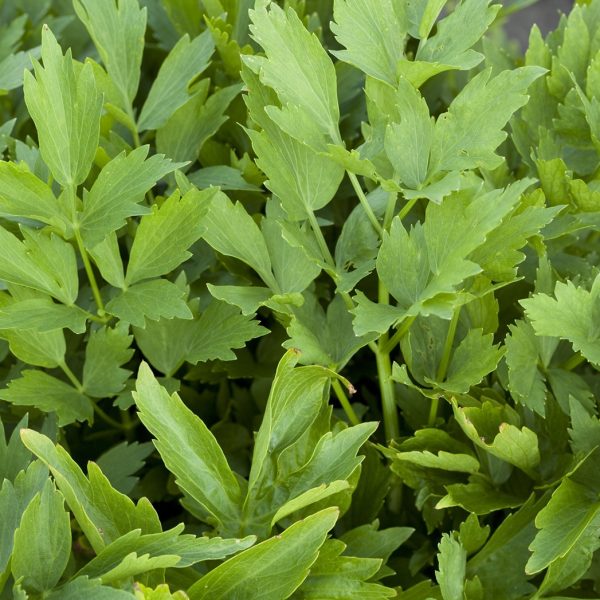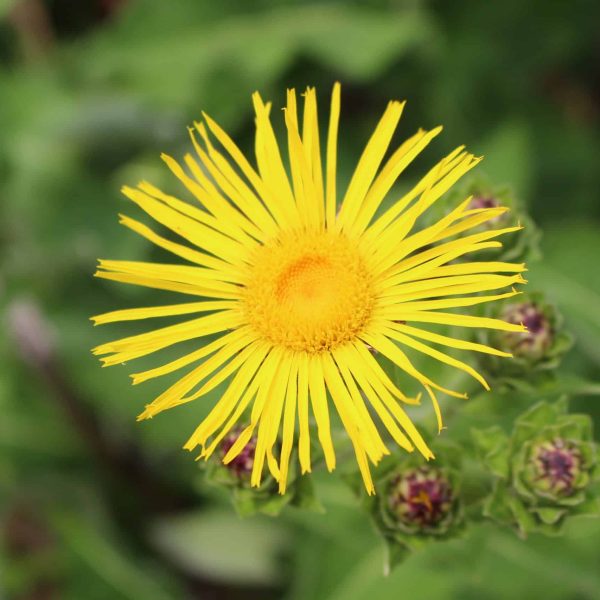-
How does it feel?
Probably the best way to appreciate the organoleptic qualities of St John’s wort is to obtain a good tincture. The first thing you will notice is that it has a deep red colour, due to its active hypericin constituent. When you taste a sip you will first notice its bitterness, though only for a short time, quickly followed by an acrid quality, and then by a more lingering aromatic and astringent, slightly resinous aftertaste. However overall the taste is short: there is little long term effect in the mouth.
From first impressions St John’s wort appears as a (blood) red, astringent remedy: ie. an ideal ‘Doctrine of Signatures’ candidate for a wound remedy, which was its original folk use. The same red ‘sanguine’ quality may have inspired its early use to raise the spirits and for melancholia.
-
What can I use it for?
 The herb and flowers of St John’s wort have been used over recent centuries throughout Europe for symptoms of nervous tension: insomnia, cramps, intestinal colic and irritable bowel, dysmenorrhoea (menstrual cramps), bed-wetting, and anxiety. It also has a reputation for relieving pains, and is taken internally, as well as applied topically, for neuralgic pains and the pain of mild burns and contusions.
The herb and flowers of St John’s wort have been used over recent centuries throughout Europe for symptoms of nervous tension: insomnia, cramps, intestinal colic and irritable bowel, dysmenorrhoea (menstrual cramps), bed-wetting, and anxiety. It also has a reputation for relieving pains, and is taken internally, as well as applied topically, for neuralgic pains and the pain of mild burns and contusions.The plant also has a traditional use as a restorative treatment for melancholic conditions, depression and the convalescence following concussion and other trauma. This combination of restorative and relaxant effect is not contradictory, and underlies the plant’s recommendation for the treatment of a number of such conditions where tension and exhaustion combine. Its most useful modern application is towards a programme of recovery from chronic fatigue conditions.
One particular example is menopause, and St. John’s wort has a specific application for the various symptoms of that change. Most of the symptoms of menopausal syndrome, the hot flushes, night sweats, depression, fatigue, irritability, lack of concentration, fluid retention and so on, were recognised as symptoms of debility long before a hormonal factor was implicated. The modern natural therapist still finds advantage in treating menopausal problems primarily as symptoms of depletion, requiring restorative and convalescent measures. St. John’s wort seems to have an ideal balance of qualities for this task: it is even felt by many of those who use it that it has a hormonal influence as well.
The red oil of St. John’s wort brings appreciable relief in the topical treatment of wounds and burns. The whole plant extract has also been used as a wound healer, and taken internally for inflammation of the upper digestive system including oesophagitis, gastritis and peptic ulceration.
-
Into the heart of st John’s wort
This herb has been regarded in British and European herbal medicine as a calming tonic, initially used for anxiety symptoms and restlessness associated with fatigue, exhaustion and in recovery from illness.
This earlier tradition is perhaps a better guide to the value of St John’s wort than to seeing it simply as an effective treatment for depression. It is when depression is combined with the symptoms above, as it often is, that this remedy comes into its own.
-
Traditional uses
St John’s wort has been used as a remedy since ancient times externally to treat ulcers, burns, wounds, abdominal pains and bacterial infections.
-
Traditional actions
Herbal actions describe therapeutic changes that occur in the body in response to taking a herb. These actions are used to express how a herb physiologically influences cells, tissues, organs or systems. Clinical observations are traditionally what have defined these actions: an increase in urine output, diuretic; improved wound healing, vulnerary; or a reduction in fever, antipyretic. These descriptors too have become a means to group herbs by their effects on the body — herbs with a nervine action have become the nervines, herbs with a bitter action are the bitters. Recognising herbs as members of these groups provides a preliminary familiarity with their mechanisms from which to then develop an understanding of their affinities and nuance and discern their clinical significance.
-
Traditional energetic actions
Herbal energetics are the descriptions Herbalists have given to plants, mushrooms, lichens, foods, and some minerals based on the direct experience of how they taste, feel, and work in the body. All traditional health systems use these principles to explain how the environment we live in and absorb, impacts our health. Find out more about traditional energetic actions in our article “An introduction to herbal energetics“.
Western energetics
-
What practitioners say
 Convalescence
ConvalescenceSt John’s wort is one of the classic tonics, medicines used to help recovery from illness, injury, exhaustion and fatigue. It combines well with Asian tonic medicines in a coordinated approach to chronic fatigue.
Nervous system
Traditional practice has emphasised the effect of St John’s wort in reducing symptoms of anxiety and restlessness, with its antidepressant benefits more recently confirmed. Anxiety and depression very often come together and it is this combination that is the best application for the remedy.
Anti-viral
St John’s wort is sometimes included in prescriptions where the body is fighting a chronic viral infection. However the evidence would suggest that this is likely to be helpful only with high doses.
Women’s health
St John’s wort is an old favourite for supporting women through the menopause. This may be associated with low energy, anxiety and depression as above and these are particularly strong indications.
-
Research
 Systematic reviews have confirmed, subject to inconsistent trial qualities, that for mild and moderate depression St John’s wort is superior to placebo in improving symptoms, and not significantly different from antidepressant medication. Adverse events reported in RCTs were comparable to placebo and fewer than with antidepressants (1). Although this has been disputed, there is evidence that benefits may even be found in major depression (2).
Systematic reviews have confirmed, subject to inconsistent trial qualities, that for mild and moderate depression St John’s wort is superior to placebo in improving symptoms, and not significantly different from antidepressant medication. Adverse events reported in RCTs were comparable to placebo and fewer than with antidepressants (1). Although this has been disputed, there is evidence that benefits may even be found in major depression (2).Reflecting older applications of St John’s wort, significant benefit in managing symptoms of the menopause (3), including hot flushes (4), has also been supported by a meta-analysis and systematic review (5).
There is also evidence for the topical effects of St John’s wort on atopic eczema (6).
The antiviral activity of constituent hypericin has been amply demonstrated in the laboratory although the clinical relevance to the activity of St John’s wort has not yet been confirmed (7).
-
Did you know?
If you collect the flowers in summer and leave them coated in olive oil out in the sun in a glass jar, a surprising red pigment will emerge into the oil at the bottom of the glass. This oil is is a great home remedy for minor scalds and burns and may also account for the plant’s name, after the bleeding head of St John the Baptist!
Additional information
-
Botanical description
St John’s wort is an erect perennial about 30-60cm high with cylindrical or oval smooth stems, branching in their upper parts and bearing opposite sessile oblong leaves with entire margins.
A key distinguishing mark against the many other Hypericum species is that on inspection against a light source they are seen to be marked with tiny translucent pinpricks (hence “perforatum”), and also with a few black spots on the underside: the veins are opaque. The bright yellow 5-petalled flowers are borne in a terminal corymb, the long lanceolate petals and shorter sepals both marked with black dots the numerous stamens are bunched into three bundles, and there are three styles.
It is found throughout Britain and the whole of Europe well into Asia, and introduced into many other parts of the world, for example North America, on roadsides, banks, woods and hedgerows, preferring open situations and relatively dry and ideally calcereous soils.
-
Common names
- Klamath weed
- Goatweed (Eng)
- Johanniskraut (Ger)
- Millepertuis (Fr)
- Erba di San Giovanni (Ital)
- Hierba de San Juan (Sp)
-
Safety
St John’s wort is mostly safe. However it may reduce the effectiveness of other medicines: it should be avoided if taking critical-dose prescriptions, especially for potentially serious conditions. It could in theory also reduce the effectiveness of the contraceptive pill. Excessive doses should also be avoided if you are sensitive to light or taking UV therapy.
Adverse effects are rare from the use of St John’s wort at recommended dosages (8).
The main concern with St John’s wort is its ability to induce key liver enzymes (cytochrome P450s or ‘CYP450s’) that break down complex non-food materials that get into the body. It may be that hyperforin is more active in this (9). This effect applies to many medicines, so that St John’s wort could reduce their effectiveness and length of action. It becomes a particular issue when the dose of that medicine is critical. So it is not wise to take St John’s wort if you are taking any critical-dose prescription, particularly for a serious condition, including immunosuppressive medication, blood thinning agents, and medicines for severe depression, epilepsy, or heart disease (10). There is also some limited evidence that St John’s wort may interfere with the effects of oral contraceptives (11).
-
Dosage
2-5 grams of dried herb and flowering tops per day.
-
Constituents
- Naphthodianthrones (0.05 to 0.6%), including hypericin and pseudohypericin (=’total hypericin’)
- Phenolics including hyperforin and adhyperforin
- Flavonoids
- Tannins
- Procyanidins
- Xanthones
- Essential oil

-
Recipe
‘Let there be joy’ Tea
Not all of life’s experiences are easy, but this tea will help you digest them with this blend of ‘instant-happiness-herbs’.
Ingredients:
- Lemon balm 3g
- Limeflower 3g
- Lavender flower 2g
- Rosemary leaf 1g
- St John’s wort flowering top 1g
- Rose water 1 tsp per cup
- Honey a dash per cup
This will serve 2 cups of happiness.
Method:
- Put all of the ingredients in a pot (except for the rose water and honey).
- Add 500ml (18fl oz) freshly boiled filtered water. Leave to steep for 10–15 minutes, then strain.
- Add the rose water and honey to taste, then sip for joy.
This recipe is from Cleanse, Nurture, Restore by Sebastian Pole
-
References
- Apaydin EA, Maher AR, Shanman R, et al. (2016) A systematic review of St. John’s wort for major depressive disorder. Syst Rev. 5(1): 148
- Linde K, Berner MM, Kriston L. (2008) St John’s wort for major depression. Cochrane Database Syst Rev. 2008 (4): CD000448
- Eatemadnia A, Ansari S, Abedi P, Najar S. (2019) The effect of Hypericum perforatum on postmenopausal symptoms and depression: A randomized controlled trial. Complement Ther Med. 45: 109-113
- Abdali K, Khajehei M, Tabatabaee HR. (2010) Effect of St John’s wort on severity, frequency, and duration of hot flashes in premenopausal, perimenopausal and postmenopausal women: a randomized, double-blind, placebo-controlled study. Menopause. 17(2): 326-331
- Liu YR, Jiang YL, Huang RQ, et al. (2014) Hypericum perforatum L. preparations for menopause: a meta-analysis of efficacy and safety. Climacteric. 17(4): 325-335
- Arndt S, Haag SF, Kleemann A, Lademann J, Meinke MC. (2013) Radical protection in the visible and infrared by a hyperforin-rich cream–in vivo versus ex vivo methods. Exp Dermatol. 22(5): 354-357
- Jacobson JM, Feinman L, Liebes L, et al. (2001) Pharmacokinetics, safety, and antiviral effects of hypericin, a derivative of St. John’s wort plant, in patients with chronic hepatitis C virus infection. Antimicrob Agents Chemother. 45(2): 517-524
- Knüppel L, Linde K. Adverse effects of St. John’s Wort: a systematic review. (2004) J Clin Psychiatry. 65(11): 1470-1479
- Whitten DL, Myers SP, Hawrelak JA, Wohlmuth H. (2006) The effect of St John’s wort extracts on CYP3A: a systematic review of prospective clinical trials. Br J Clin Pharmacol. 62(5): 512-526
- Mills E, Montori VM, Wu P, et al. (2004) Interaction of St John’s wort with conventional drugs: systematic review of clinical trials. BMJ. 329(7456): 27-30
- Berry-Bibee EN, Kim MJ, Tepper NK, et al. (2016) Co-administration of St. John’s wort and hormonal contraceptives: a systematic review. Contraception. 94(6): 668-677


























 The herb and flowers of St John’s wort have been used over recent centuries throughout Europe for symptoms of nervous tension: insomnia, cramps, intestinal colic and irritable bowel, dysmenorrhoea (menstrual cramps), bed-wetting, and anxiety. It also has a reputation for relieving pains, and is taken internally, as well as applied topically, for neuralgic pains and the pain of mild burns and contusions.
The herb and flowers of St John’s wort have been used over recent centuries throughout Europe for symptoms of nervous tension: insomnia, cramps, intestinal colic and irritable bowel, dysmenorrhoea (menstrual cramps), bed-wetting, and anxiety. It also has a reputation for relieving pains, and is taken internally, as well as applied topically, for neuralgic pains and the pain of mild burns and contusions. Convalescence
Convalescence Systematic reviews have confirmed, subject to inconsistent trial qualities, that for mild and moderate depression St John’s wort is superior to placebo in improving symptoms, and not significantly different from antidepressant medication. Adverse events reported in RCTs were comparable to placebo and fewer than with antidepressants (1). Although this has been disputed, there is evidence that benefits may even be found in major depression (2).
Systematic reviews have confirmed, subject to inconsistent trial qualities, that for mild and moderate depression St John’s wort is superior to placebo in improving symptoms, and not significantly different from antidepressant medication. Adverse events reported in RCTs were comparable to placebo and fewer than with antidepressants (1). Although this has been disputed, there is evidence that benefits may even be found in major depression (2).




